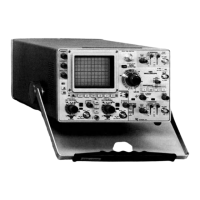Section 2—485/R485 Service
OPERATING INFORMATION
General
To effectively use the 485, the operation and capabilities
of the instrument must be known. This section describes
the operation of the controls and connections and gives
first-time and general operating information.
PRELIMINARY INFORMATION
Operating Voltage
WARNING fe
This instrument is designed for operation from a
power source with its neutral at or near earth
(ground) potential with a separate safety-earth
conductor. It is not intended for operation from two
phases o f a multi-phase system, or across the legs o f a
single-phase, three-wire system.
The 485 can be operated from either a 115 V or 230 V
nominal line voltage source, or a 220 V external battery
pack. The Line Voltage Selector switch on the rear panel
converts this instrument from one operating voltage to the
other.
Operating Temperature
The 485 can be operated where the ambient air
temperature is between —15°C and +55°C (+5°F and
+131°F). This instrument can be stored in ambient
temperatures between —55°C and +75°C (—67°F and
+167°F). After storage at temperatures beyond the opera
ting limits, allow the chassis temperature to come within
the operating limits before power is applied.
The 485 is cooled by air entering through the air filter
on the rear panel and exiting through the holes on the sides.
Adequate clearance must be provided at these locations.
Allow at least one inch clearance behind the air filter and at
least one inch on the sides.
A thermal cutout in this instrument provides thermal
protection and disconnects the power to the instrument if
the internal temperature exceeds a safe operating level.
Power is automatically restored when the temperature
returns to a safe level. Clean the air filter periodically; a
dirty filter prevents adequate air flow into the instrument.
CONTROLS AND CONNECTORS
Power Cord Conductor Identification
Conductor
Color Alternate Color
Ungrounded (Line)
Brown Black
Grounded (Neutral)
Blue White
Grounding (Earthing) Green-Yellow Green-Yellow
CAUTION
This instrument may be damaged if operated with the
Line Voltage Selector switch set to incorrect posi
tions for the line voltage applied.
115 V 90-136 V
230 V 180-272 V
General
The major controls and connectors for operation of the
485 are located on the front panel of the instrument. Some
auxiliary functions are provided on the side, top, bottom
and rear panel. To make full use of the capabilities of this
instrument, the operator should be familiar with the
function and use of each of these controls and connectors.
A brief description of each control and connector is given
here.
Front Panel
POWER Pushbutton Turns instrument on or off.
CAL 5 V Connector BNC connector for square-wave
voltage calibrator output signal.
The 485 is designed to be used with a three-wire AC
power system. If the three to two-wire adapter is used to
connect this instrument to a two-wire AC power system, be
sure to connect the ground lead of the adapter to earth
(ground). Failure to complete the ground system may allow
;he chassis of this instrument to be elevated above ground
potential and pose a shock hazard.
FREQ Pushbutton Selects one of two frequencies (1
kHz or 1 MHz) for the fast-rise
calibrator signal.
INTENSITY Control Controls intensity of writing beam.
B INTENSITY Provides additional intensity con-
Control trol for the B SWEEP.
REV. C. MAR. 1977
2-1

